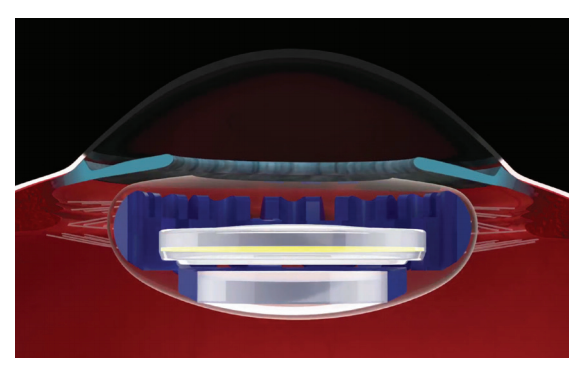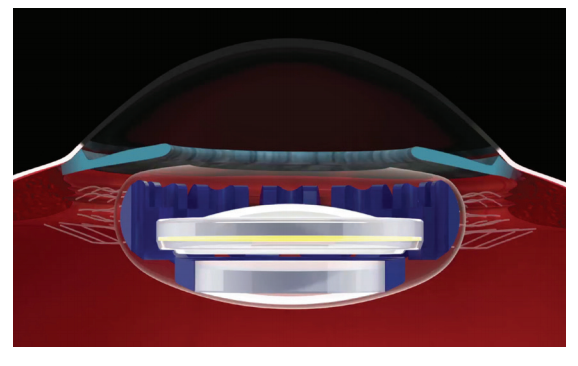Article
Curvature-changing IOL: New frontier in cataract and presbyopia surgeries
Author(s):
Lens offers full range of vision from distance through near vision.
(Figure 1) The lens can be set for distance (pictured above) or intermediate and near sight (picture below).(Photos courtesy of Eric D. Donnenfeld, MD)

This article was reviewed by Eric D. Donnenfeld, MD
A modular, curvature-changing IOL (Juvene; LensGen, Inc) improves vision at all distances and the outcomes remained stable 1 year after implantation.
This novel IOL comprises a base lens supported by circumferential silicone haptics that fill the capsule and a fluid lens that fits into the base lens and facilitates continuous range of vision from distance to near focus.
Related: Making sutureless double-needle scleral IOL fixation technique more accessible
“The 2 lens are modular and the refractive lens is implanted in the base lens and can be implanted in the eye through a small incision,” according to Eric D. Donnenfeld, MD, a founding partner at Ophthalmic Consultants of Long Island and Connecticut, clinical professor of ophthalmology at New York University, and a trustee of Dartmouth Medical School, Hanover, New Hampshire.
Forty-seven eyes of 33 patients (mean age, 66.7 ± 7.7 years) received the IOL and were evaluated after 12 months.
The investigators measured the stability of the manifest refractions, best-corrected distance visual acuities (VAs), distance-corrected intermediate and near VAs (DCIVA and DCNVA), and defocus curves.
Data from 2 eyes were not analyzed because of adverse events not related to the IOL. Monocular data were obtained from 45 eyes and binocular data from 14 patients.
Donnenfeld reported that the mean postoperative manifest refraction spherical equivalent did not change significantly over the 12 months of the study.
Related: Early clinical experience with next-generation lens

Monocular and binocular results
The monocular BDCVA at 12 months was 20/20, the DCIVA 20/25+1, and the DCNVA 20/32-2.
“The patients had excellent distance VA; all patient had at least 20/25. The intermediate VA also was excellent, with more than 90% of patients achieving 20/25. The mean DCNVA was 20/32 in about half of the patients; most patients achieved 20/40,” Donnenfeld said.
Analysis of the binocular VA showed improvement likely from a summation effect. The distance, intermediate, and near VAs were, respectively, 20/20, 20/20, and 20/32. Almost all patients achieved these VAs at all 3 distances.
The monocular focus curves achieved supported the VA results, he pointed out. In 45 eyes, the mean defocus VAs for distance, intermediate, and near vision, respectively, were 20/20, 20/32, and 20/40+.
The defocus curves had no peaks or troughs but were relatively flat and stable shelves.
Related: Iris-fixated IOLs are a boon for treating high myopia
The binocular defocus curves in 14 patients for distance, intermediate, and near vision were, respectively, 20/20+, 20/25, and 20/40.
“Binocular summation yields better results and is not due to a monovision effect,” Donnenfeld said.
Conclusion
According to Donnenfeld, these results suggested that this novel shape-changing IOL provides a full range of vision from distance through near vision.
“It was noteworthy that there was almost no glare or halo with this IOL,” he concluded. “Bilateral implantation provides improved vision at all distances, which suggested binocular summation. In addition, the outcomes were stable out to at least 1 year, which was the final study visit.”
--
Eric D. Donnenfeld, MD
E: ericdonnenfeld@gmail.com
Donnenfeld is on the scientific advisory board of LensGen, Inc.
--
Newsletter
Don’t miss out—get Ophthalmology Times updates on the latest clinical advancements and expert interviews, straight to your inbox.




